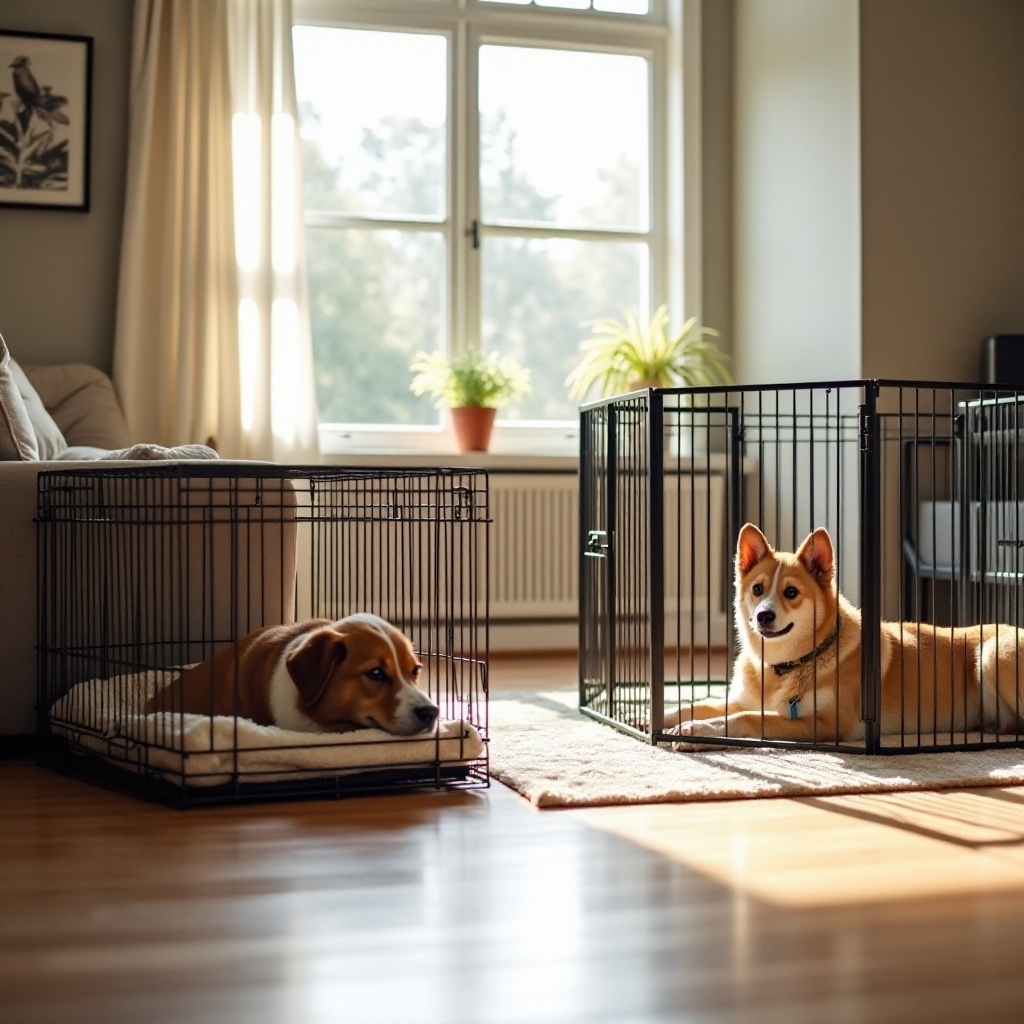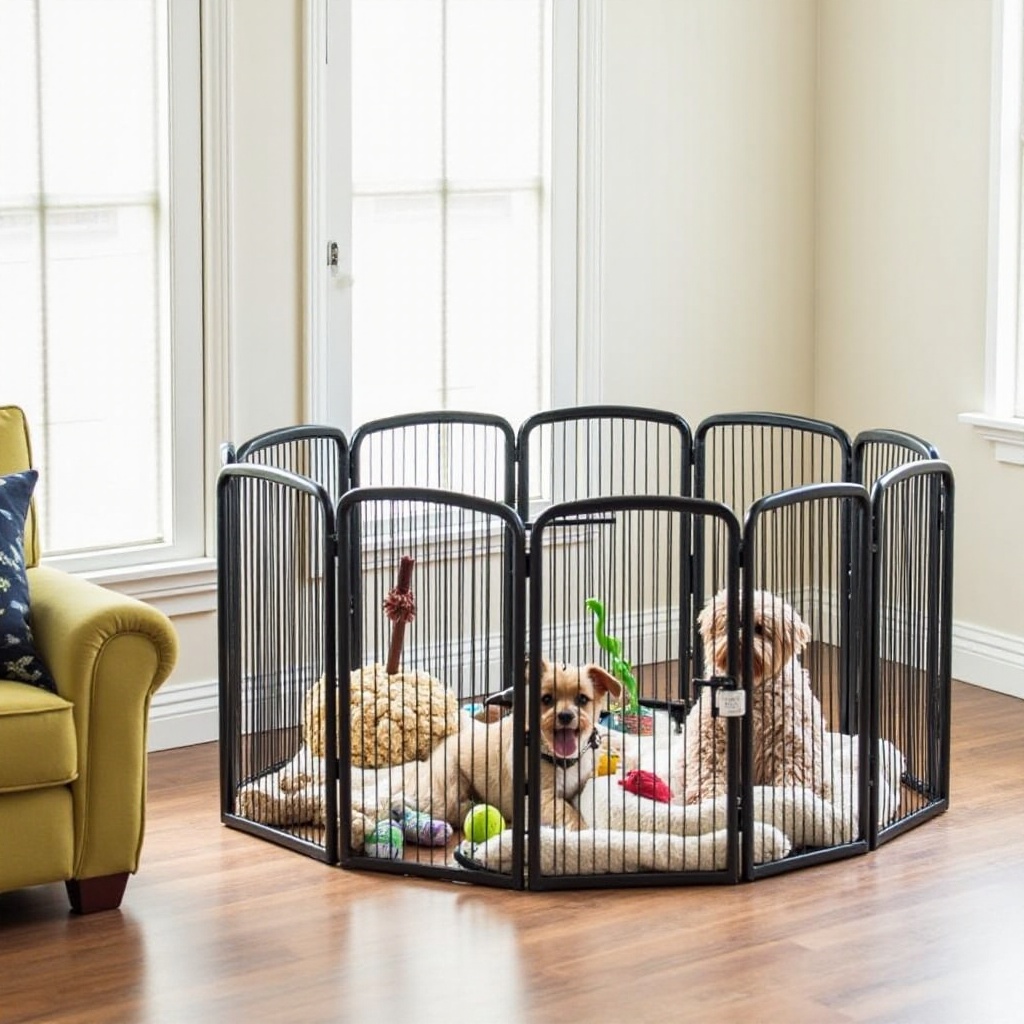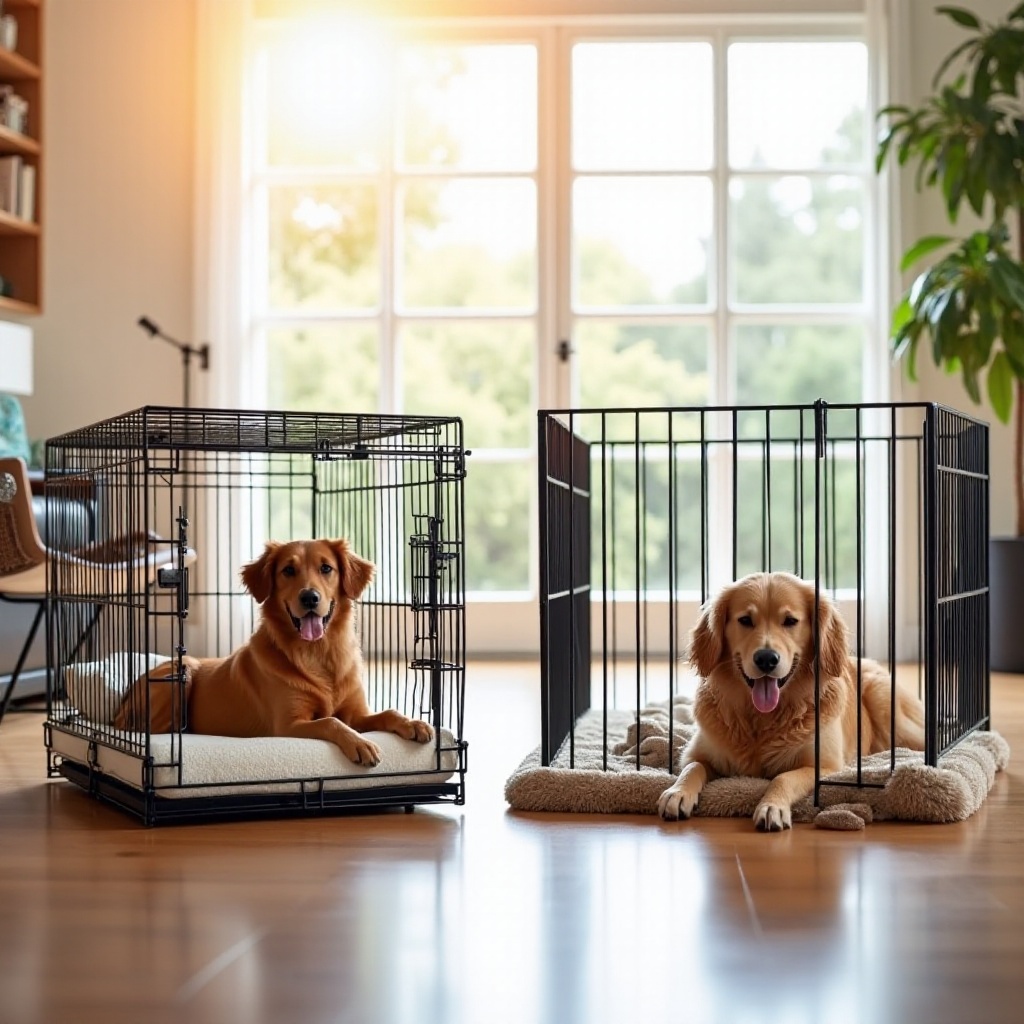Introduction
Choosing between a dog crate and a playpen can be a tough decision for pet owners. Both offer unique benefits and can serve different purposes, making it essential to understand their differences. By understanding these aspects, you can make an informed decision that best meets your dog’s needs and your lifestyle.

What is a Dog Crate?
A dog crate is an enclosed space designed to serve as a safe and secure area for your dog. Crates come in various styles and sizes, catering to different breeds and needs.
Types of Dog Crates
- Wire Crates: Made from metal wire, these crates are well-ventilated and fold easily for storage.
- Plastic Crates: Ideal for travel, plastic crates provide a den-like environment and are often used for airline transport.
- Fabric Crates: Lightweight and portable, these crates are perfect for well-behaved dogs on the go.
- Wood Crates: Stylish and sturdy, these crates can double as furniture in your home.
Key Benefits of Dog Crates
- Training: Crates help with house training by allowing dogs to learn bladder control.
- Safety: A secure place to keep your dog when you’re not at home or during travel.
- Behavioral: Reduces anxiety and destructive behavior by providing a personal space.
What is a Dog Playpen?
A dog playpen, on the other hand, is an enclosed, open-top area that gives your dog more freedom to move around while still being confined.
Types of Dog Playpens
- Indoor Playpens: Made from plastic or metal, these playpens are designed for indoor use.
- Outdoor Playpens: Typically more durable, these playpens are weather-resistant and suitable for outdoor environments.
- Convertible Playpens: These can be adjusted or reconfigured to suit different spaces and needs.
Key Benefits of Dog Playpens
- Freedom: Allows more space for your dog to move around compared to a crate.
- Socialization: Easy for dogs to interact with family members and pets while confined.
- Versatility: Can be used both indoors and outdoors, providing flexibility in confinement.

Dog Crate vs Playpen – Key Differences
When deciding between a dog crate and a playpen, it’s important to understand the key differences.
Space and Mobility
Dog crates are typically more confined, offering limited space for movement, which can be ideal for training and travel. Playpens, however, provide significantly more space, allowing your dog to walk, play, and interact within the confined area.
Training and Behavior Impact
Crates are highly effective in house training and managing behavioral issues like anxiety and aggression by offering a den-like environment. Playpens, while not as effective for training, can help in socialization and preventing destructive behaviors by allowing your dog room to move.
Practical Use and Convenience
Crates are generally easier to transport and can double as travel carriers. They are also easier to store when not in use. Playpens are more versatile in terms of space but can be cumbersome when it comes to set-up and storage, given their size.

Choosing the Right Option for Your Dog
When deciding between a dog crate and a playpen, consider your dog’s specific needs and your lifestyle.
Assessing Your Dog’s Needs
- Age: Puppies might benefit more from crates for training, while adult dogs might enjoy the freedom of a playpen.
- Size: Larger breeds might find playpens more comfortable, while smaller breeds could feel more secure in a crate.
- Behavior: Anxious or destructive dogs might benefit from the security of a crate, while social dogs might do better in a playpen.
Evaluating Your Living Situation and Lifestyle
- Space: Smaller living spaces might accommodate a crate better, while homes with more room can easily incorporate a playpen.
- Routine: Consider whether you have a stable routine or travel frequently. Crates are great for travel and routine use, while playpens are more suited for flexible home environments.
Tips for Using Dog Crates and Playpens Effectively
Utilizing dog crates and playpens effectively requires proper setup and training.
Setting Up a Dog Crate
- Location: Place the crate in a quiet, low-traffic area.
- Comfort: Add a soft bed or blanket inside.
- Accessibility: Keep the door open initially so your dog can explore.
Setting Up a Dog Playpen
- Space: Ensure there is enough room for play and movement.
- Comfort: Include some of your dog’s favorite toys and bedding.
- Safety: Make sure the area is free of hazards.
Training Tips for Crate and Playpen Acclimatization
- Positive Reinforcement: Use treats and praise to encourage your dog to enter.
- Gradual Increase: Start with short periods and gradually increase the time.
- Consistency: Maintain a consistent routine to help your dog adjust.
Conclusion
Choosing between a dog crate and a playpen comes down to understanding your dog’s needs and evaluating your lifestyle. Crates offer security and are great for training, while playpens provide more freedom and space. Both can be excellent options if used correctly.
Frequently Asked Questions
Can I use both a crate and a playpen for my dog?
Yes, using both can be beneficial. Crates can be used for training and travel, while playpens can offer a safe space for play and social interaction.
How long can I leave my dog in a crate or playpen?
It’s recommended not to leave dogs in a crate for more than 4-5 hours during the day. Playpens can allow longer periods but still require regular breaks for exercise and interaction.
Is a crate or playpen better for a puppy?
A crate is often better for puppies due to its effectiveness in house training and providing a secure space. However, supervised playtime in a playpen can also be beneficial.
